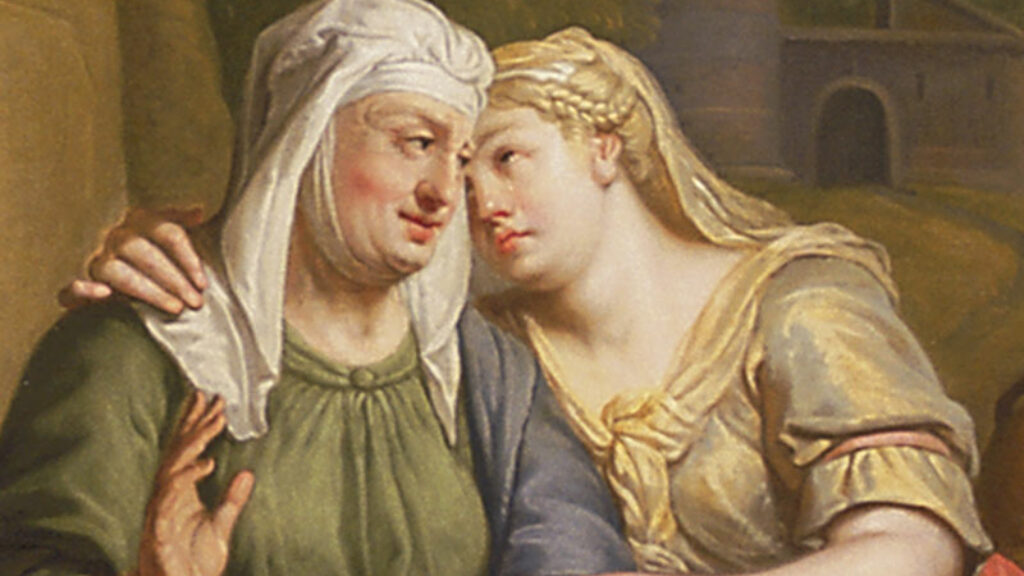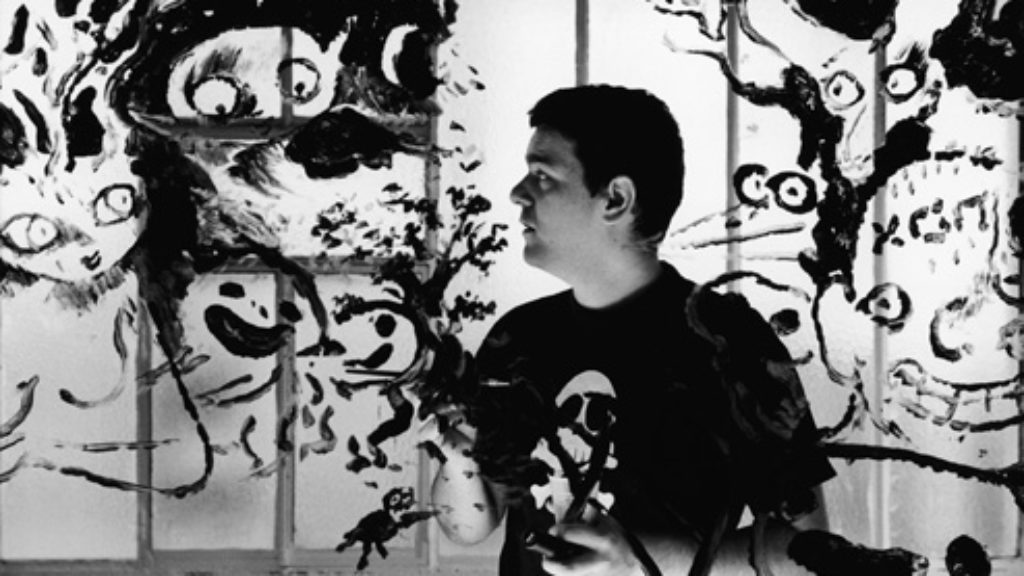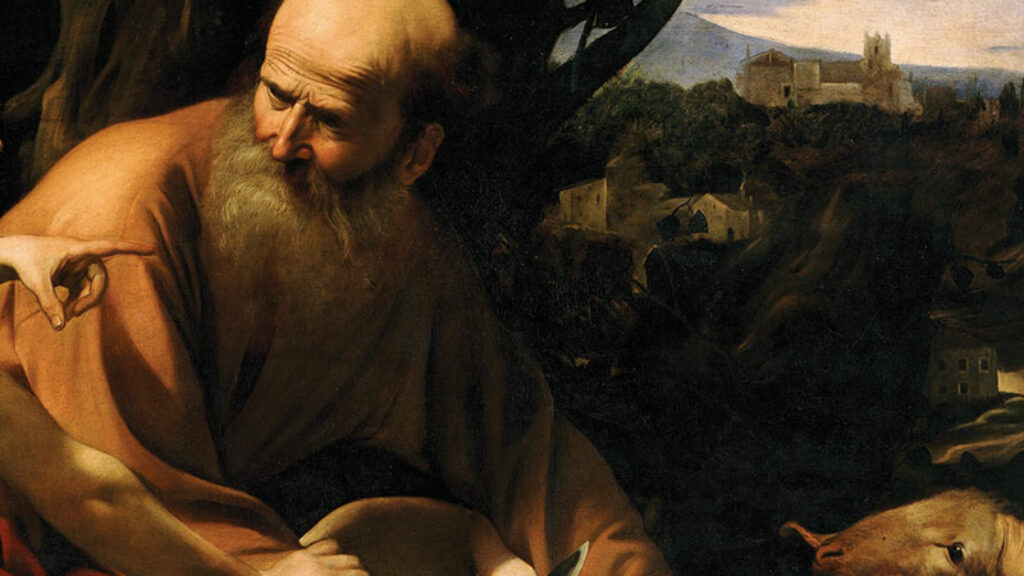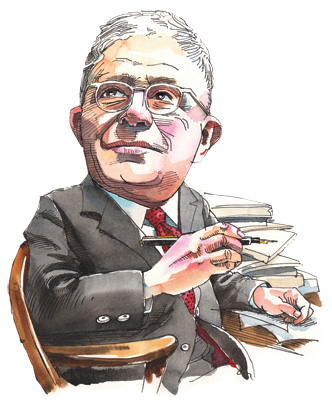Re-Intoxicated by God
Near the beginning of The Family Moskat, Isaac Bashevis Singer introduces us to a young man from a distinguished rabbinic family named Asa Heschel Bannet:
At five he was studying Talmud, at six he began the Talmudic commentators, at eight the teacher had no more to give him. At the age of nine he delivered a discourse in the synagogue, and at twelve he was writing learned letters to rabbis in other towns . . . [who] would send him back long epistles, addressing him as “The Keen and Eagle-eyed” and “Uprooter of Mountains.”
We meet Bannet as he arrives in Warsaw and are given a glimpse of how far he has travelled from the piety of his youth: “In his pocket rested a worn volume, the Ethics of Spinoza in a Hebrew translation.”
The figure of talmudic prodigy gone bad is an old one going back to the 18th-century Polish Jewish thinker Salomon Maimon. The way out is clearly marked: Intense Talmud study leads to intense study of science and philosophy. Questioning within the framework of rabbinic Judaism is replaced by questioning the framework of rabbinic Judaism itself. Spinoza was (in fact, sometimes still is) a crucial step along the path out.
There are many reasons that talmudic geniuses were attracted to the Dutch-Jewish heretic. In his Theological-Political Treatise, Spinoza critiques the Bible and challenges central tenets of traditional Judaism. But more often than not it was Spinoza’s Ethics, not the Treatise, that was the lure. According to the Ethics, the good life consists in cultivating intellectual and moral perfection, goals that seem consistent with the aims of a Talmud student. But for Spinoza intellectual perfection consists not in mastering the Talmud but rather in scientific knowledge of nature. And while Spinoza shares the rabbinic aim of cultivating moral virtues such as generosity and gratitude, he finds no value in ritual practice.
Harry Austryn Wolfson was one of the most notable talmudic prodigies turned unbeliever. Trained in the legendary Slobodka yeshiva, Wolfson held the first chair in Jewish studies at an American university. For almost 50 years, he was the Nathan Littauer Professor of Hebrew Literature and Philosophy at Harvard, until his death in 1974. In 1934, Wolfson published The Philosophy of Spinoza: Unfolding the Latent Processes of His Reasoning, a monumental two-volume study of the Ethics. At the beginning of the book, Wolfson considered Spinoza’s philosophical method. Spinoza modeled his Ethics on Euclid’s Elements, beginning with definitions and self-evident axioms, then presenting propositions that he proved using the definitions, axioms, and prior propositions. But beneath Spinoza’s ostensibly geometrical method, Wolfson discerned a deeper talmudic approach:
In its concentrated form of exposition and in the baffling allusiveness and ellipticalness of its style, the Ethics may be compared to the Talmudic and rabbinic writings upon which Spinoza was brought up, and it is in that spirit in which the old rabbinic scholars approach the study of their standard texts that we must approach the study of the Ethics.
One lapsed yeshiva bocher recognized another, or at least thought he did (Spinoza had considerably less rabbinic learning than did Wolfson).
On the surface, comparing Spinoza’s method in the Ethics to the Talmud is outlandish. The Talmud is a hodgepodge of rabbinic opinions associatively linked to other rabbinic opinions, which argues over the meaning of prior rabbinic statements and cites scriptural prooftexts. By contrast, Spinoza constructs a methodical, self-contained philosophical system, which rarely interprets other philosophers or cites prooftexts. Nonetheless, Wolfson brashly asserted that “if we could cut up all the philosophic literature available to [Spinoza] into slips of paper, toss them up into the air, and let them fall back to the ground, then out of these scattered slips of paper we could reconstruct his Ethics.”
Just as the Talmud reads every word of the Mishnah with great care, seeking to understand how the mishnaic rabbis based themselves on biblical authority and why one rabbi’s opinion differs from another, so Wolfson saw Spinoza as carefully choosing each word of his Ethics, in implicit dialogue with earlier philosophical authorities, accepting, modifying, or rejecting them.
For Wolfson, Spinoza was the culmination of rabbinic scholasticism as evidenced by the title he originally chose for his book: Spinoza the Last of the Mediaevals: a Study of the Ethica Ordine Geometrico Demonstrata in the light of a hypothetically constructed Ethica More Scholastico Rabbinicoque Demonstrata. Wolfson, who had a dry sense of humor, wrote that the only reason he abandoned this title was because “it did not seem advisable to have the title begin with the word ‘Spinoza.’”
Thirty-five years after Wolfson published his magnum opus, a second monumental interpretation of Spinoza appeared. In Spinoza’s Metaphysics: An Essay in Interpretation, Edwin Curley, an analytically trained philosopher (and lapsed Christian), revolutionized Spinoza studies. Curley attempted to provide a “coherent and precise explanation” of Spinoza’s metaphysics by showing that the philosopher espoused a “consistent, reasoned view of the world” not merely by 17th-century standards, but by the standards of 20th-century Anglo-American philosophy. Consequently, Curley was entirely unapologetic about presenting Spinoza’s system in “a philosophical vocabulary which was entirely unfamiliar to Spinoza.”
Yitzhak Melamed’s important new study, Spinoza’s Metaphysics: Substance and Thought, is far too dense and intricately argued to sum up, but it would be fair to say that he enters into this argument, and improves upon both Wolfson and Curley, which is an extraordinary accomplishment.
The 18th-century German Romantic Novalis famously described Spinoza as a “God-intoxicated man” who identified God with the cosmos, and Spinoza has been widely considered a pantheist since then. For all the differences between Wolfson and Curley, they agreed on one striking conclusion—the notion that Spinoza was a pantheist was wrong. Wolfson argued that Spinoza saw God as merely the highest conceptual category through which all else was conceived, while Curley contended that Spinoza identified God with the fundamental principles of natural science. One of Melamed’s most important contributions is that he rehabilitates the traditional view of Spinoza as a pantheist.
To illustrate the differences between Wolfson’s, Curley’s, and Melamed’s approaches, we must understand their interpretations of one of the key elements of Spinoza’s metaphysics, his distinction between substance and modes. At the beginning of the Ethics, Spinoza divided Being into two: Substance was that which “is in itself and is conceived through itself” while modes were “the affections of substance or that which is in another through which it is also conceived.” For Spinoza, God was the only substance while finite things like a jousting lance (not to speak of you and me) were modes of substance. Infinite extension and infinite thought were God’s attributes.
Wolfson observed that medieval philosophers frequently began by dividing Being into two, though they spoke of substance and accidents. Their substance existed in itself while accidents existed in something else. Thus, for the medievals, God was a substance but so were finite things like the jousting lance. Contingent features of finite things such as the blackness of a particular jousting lance were accidents. Wolfson assumed that Spinoza’s starting point was this medieval division of Being, and on this basis he raised several questions. Why did Spinoza use the term “mode” instead of “accident”? Why did he deny that there were finite substances, asserting that God was the only substance? Why did he add the condition of “being conceived through itself” to the definition of substance and “being conceived through another” to the definition of modes?
The medievals assumed that blackness was an accident of the jousting lance because the lance’s blackness could not exist outside of it. The jousting lance, however, was a substance since it could be moved from one place to another while retaining its form. Wolfson hypothesized that Spinoza worried that while it was true that a jousting lance could be moved, it could never exist outside of space. So finite things must be modes of the only true substance, God, one of whose attributes is infinite extension. According to Wolfson, Spinoza replaced the term “accident” with “mode” because he thought that an accident can be conceived without a substance while a mode cannot. For example, while I can conceive of blackness without extension, I can’t conceive of a jousting lance without extension.
On this basis, Wolfson argued that Spinoza’s distinction between substance and mode was similar to that between a genus and a species. Just as the genus “animal” includes the species “human being,” so the genus “substance” includes all finite modes, including our lance. Wolfson interpreted Spinoza’s definition of mode, namely “that which is in another through which it is also conceived,” as meaning that a mode is “in another” in the sense that it is conceived through another. For Wolfson’s Spinoza, modes do not inhere bodily in substance, so all things do not inhere in God. Hence, he was not a pantheist, at least not in the conventional sense of the term.
Curley rejected Wolfson’s interpretation, though not his conclusion. “Many logicians nowadays, with Russell’s paradoxes in mind, would,” he wrote, “reject the notion of a class being a member of itself as unintelligible.” And yet that was precisely what Wolfson’s Spinoza held with regard to substance. Curley also noted that Spinoza denied that a genus could cause anything, since it was just a philosophical abstraction. So if God was the highest genus, it could not cause anything. Yet Spinoza explicitly asserted that God was the cause of all things.
What, then, was the proper understanding of the relationship between Spinoza’s substance and its modes? Was Spinoza, in fact, a pantheist? Curley observed that the first person to interpret Spinoza as a pantheist was Pierre Bayle in his 1697 Historical and Critical Dictionary. But he also argued that such pantheism was incoherent. First, Bayle argued that if modes were properties of the one substance, that is God, then God would have contradictory properties. For example, Hillary Clinton supported the war in Iraq and Barack Obama opposed it. Since Clinton and Obama are both properties of God, God both supported and opposed the war in Iraq, which violates the principle of non-contradiction. Second, Bayle noted that finite modes were constantly changing. Barack Obama is born, rises to power, and dies. But Spinoza held that God is immutable. Finally, Bayle wrote that finite beings regularly commit evil acts. But if finite beings inhere in God then God was responsible for evil, which was theologically unacceptable. To Bayle’s objections, Curley added one of his own. When we say that a quality inheres in something we generally mean that the quality is predicable of it. For example, being 2,722 feet high is predicated of the Burj Khalifa tower in Dubai. But since finite modes are things, if Spinoza saw finite modes as predicable of God, then he committed a category error, since one thing cannot be predicated of another.
If Spinoza were susceptible to such criticism, then it would turn out that he did not really have a “consistent, reasoned view of the world,” either in his terms or our own. So Curley constructed what he called a “model metaphysic” based on early-20th-century British philosophy to reinterpret Spinoza’s account of substance and modes. According to this “model metaphysic,” there are three levels of reality. First, are the fundamental laws of nature, which are true and could never have been otherwise. Then there are singular facts such as that the Burj Khalifa is 2,722 feet high, which are only accidentally true, since it could have been 2,721 feet high. Between the fundamental laws and the singular facts are what Curley calls “derivative nomological facts,” that is, less general scientific generalizations that follow from the laws of nature, such as the law of inertia. This, according to Curley, was what Spinoza was getting at in his distinction between substance and modes. For Curley, Spinoza’s God, or substance, which was known through God’s attributes, was equivalent to the fundamental laws of nature. Singular facts were finite modes. Between substance and finite modes were the infinite modes, which were equivalent to Curley’s “derivative nomological facts.”
Curley agreed with Wolfson that Spinoza was no pantheist. But for Curley, the relationship between God (substance) and finite modes was causal, not conceptual. Since all finite modes existed by virtue of the fundamental laws of nature, God could be said to cause them. But as the finite modes neither existed within God nor were predicated of God, God was not equivalent to them.
Yitzhak Melamed agrees that Curley effectively dismantled Wolfson’s interpretation and hence does not feel the need to address it. Rather, he takes as his task doing to Curley’s interpretation what Curley did to Wolfson’s. Melamed begins by carefully summarizing Curley’s interpretation of the substance-mode distinction and his arguments for it. He then presents 13 arguments against Curley’s reading. Needless to say, the pages of the Jewish Review of Books do not have the attribute of infinite extension, so I will focus on three of his arguments.
Curley and Melamed agree that Spinoza affirmed the medieval philosophical view that God is omniscient. But, Melamed asks, if finite modes do not inhere in God, and ideas are finite modes, what does it mean for God to be omniscient? In Curley’s view, Spinoza’s God was the cause of ideas, but they did not inhere in Him. Consequently, God was ignorant, something that Spinoza explicitly rejected. Second, Melamed cites a letter in which Spinoza said that he maintained “together with Paul and perhaps together with all ancient philosophers” that “all things are in God and move in God.” Melamed notes that the idea that all things “move in God” is unintelligible on Curley’s reading. He also notes that if Spinoza’s phrase that “all things are in God” simply meant that God was the cause of all things, it is unclear why he would have invoked the “ancient philosophers.” For Spinoza’s own contemporaries universally maintained that God was the cause of all things.
Finally, Melamed observes that in Spinoza’s unpublished Compendium of the Hebrew Grammar he drew an analogy between parts of speech and metaphysical divisions of reality. Spinoza asserted that nouns correspond with substance, adjectives with attributes, and participles with modes. For example, the noun “man” (ish) is a substance, the adjective “big” (gadol) is an attribute, and the participle “walk” (holekh) is a mode. Spinoza explained that the difference between adjectives and participles is that adjectives refer to aspects of the noun that are static and not related to time, while participles refer to aspects of the noun that change and are related to time. So a man being big is a static property, while his walking is contingent and changes. Since participles are properties of nouns, it is clear that Spinoza saw modes as properties of substance.
In response to Bayle’s contention that in the pantheistic view God has contradictory properties, Melamed argues that contradiction is only apparent. The fact that finite modes contradict each other creates no contradiction in God. For it may be that insofar as God is Hillary Clinton God supported the war in Iraq, but insofar as God is Barack Obama God did not. Melamed has little problem dispensing with Bayle’s second objection, namely that pantheism makes God responsible for evil. For, as Spinoza told us time and again, good and evil are human constructs. Regarding Bayle’s final objection, the problem of divine immutability, Melamed bites the bullet and argues that Spinoza did not actually deny the possibility of change in God. Reading closely, Melamed notes that what Spinoza claimed was that “God, or all of God’s attributes, are immutable.” According to Melamed, Spinoza was claiming only that God insofar as He is expressed through His attributes is immutable, not God insofar as He is expressed through His modes.
Melamed further rejects Curley’s claim that if Spinoza held that modes could be predicated of God he would have been committing a category error. Melamed notes that Spinoza’s contemporaries such as Leibniz and Arnauld thought that finite modes could be predicated of substances or even of other modes. Melamed also argues that for Spinoza there was no problem with finite things being in God without being part of God. Aristotle himself claimed that knowledge of grammar is in the soul, without being part of it. Melamed contends that Spinoza saw modes as properties that followed from God’s essence without being identical to it.
Finally, Melamed writes that Curley’s claim that things cannot be predicated of other things was not necessarily a category error since, as Russell argued, things can be understood as merely “bundles of co-existing qualities” and qualities can be predicated of substances. In this way, Melamed clears the way to reestablishing the pantheistic interpretation of Spinoza.
Melamed’s polemic with Curley is not just about Spinoza. He sees Curley’s approach to Spinoza as symptomatic of a broader problem in the way many philosophers study the history of philosophy. For a long time, analytic philosophers have ruled Anglo-American philosophy departments and embattled historians of philosophy have tried to justify their existence by showing how old philosophers can contribute to contemporary analytic debates. Melamed agrees that contemporary philosophy can, in fact, learn from historical figures, but he has misgivings about the way this aim is often pursued. Curley’s interpretation of Spinoza, he argues, exemplifies the problem.
Historians of philosophy, such as Curley, often speak of the “principle of charity”: One assumes that great philosophers have not committed elementary philosophical blunders. When applied modestly, Melamed agrees that this is good historical practice. But too often the principle is invoked to legitimize wildly anachronistic interpretations. For Melamed, Curley’s “model metaphysic” is just such an interpretation. The value of studying old philosophers is, he argues, that they help us question contemporary assumptions and open new avenues for philosophical thinking. As he puts it, “The price we pay for making Spinoza like us is that it is no longer clear why we should have an interest in Spinoza.” Instead, Melamed proposes that we be open to reading philosophers according to their original intentions as a way of “challeng[ing] (rather than confirm[ing]) our most basic beliefs and intuitions . . . [to] help us diagnose our own blind spots.”
Seen from the perspective of contemporary analytic philosophy, Spinoza’s pantheism may seem to commit a category error, but for Melamed true charity bids us to read the Ethics within its historical context—and be open to the possibility that Spinoza might have been right. For example, by taking seriously Spinoza’s claim that finite modes are things but inhere in substance, Melamed sees Spinoza as questioning the common philosophical assumption that there is a clear-cut distinction between properties and things.
Melamed’s general point about the misuse of the principle of charity is well-taken (and he is not alone in making it), but the dividing line between appropriate and inappropriate uses of the principle is not always so clear. Why, for example, is Curley’s use of the “model metaphysic” to explain Spinoza out of bounds, while Melamed’s use of Russell’s notion of things as “bundles of qualities” is fair game? Every scholar, it seems, must strike a balance between textual evidence, conceptual clarity, and logical consistency. These will always, and necessarily, be matters of judgment.
While Melamed rejects Wolfson’s interpretation of Spinoza as much as Curley’s, he does intimate that he shares a kinship with Wolfson in a different respect. In his acknowledgements, Melamed refers to his numerous discussions of “Reb Boruch Ha-Sefaradi” since emigrating from the ultra-Orthodox “holy city of Bney Brak.” In thanking his dissertation advisor, the Yale philosopher Michael Della Rocca, he lauds him as “an ideal Talmudic sage.” On close inspection, one can also discern a talmudic sensibility that informs Melamed’s approach to Spinoza, albeit one that differs from Wolfson’s. Like Wolfson, Melamed explores how Spinoza uses key philosophical sources through careful textual analysis and dialectical argument. But while Wolfson’s dialectic was mostly internal to Spinoza and his purported sources—asking why and how Spinoza departed from his medieval philosophical predecessors—Melamed’s dialectic is usually directed at a prominent modern interpretation of Spinoza.
Melamed presents a given interpretation and his alternative, and then offers a series of textual and conceptual objections to the influential interpretation. He then considers possible responses to his objections and refutes them. If Wolfson’s approach was akin to that of the talmudic sages in relation to their mishnaic predecessors, Melamed’s is more like tertiary medieval commentators such as Tosafot who defended their interpretations by refuting prior commentators like Rashi. Admittedly this approach is not unique to Melamed—all historians of philosophy, Curley included, must proceed like this to some degree. But the level of Melamed’s attention to textual detail combined with his logical acuity is unusual even among Spinoza scholars and may owe something to his talmudic training.
I wonder if I detect a debt to Talmud study in one other aspect of Melamed’s scholarship. Every student of the Talmud knows that the Talmud tends to give priority to older rabbinic opinions over newer ones, presupposing a “decline of the generations.” Perhaps Melamed’s talmudic sensibility inclines him to take seriously the possibility that a 17th-century rationalist may have understood certain problems better than analytic philosophers of the 20th and 21st centuries.
Comments
You must log in to comment Log In
Suggested Reading

Haredim and COVID-19: Tenants or Landlords?
Between rabbinic rulings and public policy: a response from Daniel Goldman and Yossi Shain and a rejoinder from Yehoshua Pfeffer.

Friendship in the Fields of Moab
Naomi and Ruth have mourned together and are now setting off on the 50-mile journey from the plains of Moab to Bethlehem, toward an uncertain future—alone but side by side.

Drawing Conclusions: Joann Sfar and the Jews of France
The great French comic artist is now working at the height of his considerable powers, and he is obsessed with questions of Jewish identity and life in Europe.

Take Your Son . . .
A new book about the interpretation of the most terrifying verses in the Hebrew Bible.


Zachary Gartenberg
Dear Professor Gottlieb,
Thank you very much for this review, which I believe does justice to the scope and depth of Melamed's work and nicely relates it to earlier systematic attempts at interpreting Spinoza's philosophy (a theme which other reviews of the book tend to overlook, as they are often more concerned with the philosophical details of Melamed's interpretation).
I thought I would add a few reflections to your insight on the "principle of charity" which Melamed criticizes (though, as you point out, does not wholly reject). You write that " Every scholar, it seems, must strike a balance between textual evidence, conceptual clarity, and logical consistency. These will always, and necessarily, be matters of judgment." I think this is a judicious way of expressing what's at stake in the practice of interpreting past philosophers. I would add, simply by way of augmenting this insight, some further considerations that bear on the study of philosophy's history.
As is well known, both Spinoza and Leibniz endorsed what A.O. Lovejoy called the "principle of plenitude" -- reality has no gaps -- and this principle was seen by both as imbuing reality with kind of repleteness that was tantamount to its perfection. I think that we can appropriate this principle in assessing the traditions of commentary and interpretation that spring from the work of a given philosopher. Over time, the richness and variety of interpretations that arise concerning the work of a particular thinker flesh out his or her thought and bring to light the issues it addresses in a way that reflects the fullness and depth of that thought itself. Not all interpretations are equally well-justified -- and systematic interpretations are perhaps most prone to harboring blind-spots -- but embracing the "plenitude" of interpretive possibilities (constrained as this attitude must be by judgment, evidence, and the need for conceptual clarity and proper sensitivity to context) implies a simultaneous embrace of the inherent complexity of reality and of the multifaceted ways there are to try to grasp it. (Surely this reality includes the thought of other individuals as much as it does "the world.")
Learning from past philosophers may furnish a platform for exploring problems that seem urgent to us, but Melamed is right to criticize the view that this is all that "charity" seeks to accomplish. More important, studying the history of philosophy provides (to borrow a trope from Robert Frost) a much-needed "harness" within which to "work well" on solving philosophical problems and understanding their etiology. By means of such an approach, historians of philosophy are equipped to appreciate the continuities that span philosophical thinking over time and which will continue to do so (regardless of how acutely present-day philosophers are aware of these continuities).
It is often unrecognized just how necessary a tradition of thought on a problem or commentary on a thinker is to the attempt to understand the problem (or thinker). Reflection on philosophical problems does not unfold like a deductive chain from the work of one person to next (or, for that matter, within the thought of a single philosopher). And it shouldn't. As C.S. Peirce remarked, "reasoning should not form a chain which is no longer than its weakest link, but a cable whose fibres may be ever so slender, provided they are sufficiently numerous and intimately connected." Peirce's metaphor for successful reasoning could well be applied to the assessment of a body of previous work on a given philosopher such as Spinoza. (Peirce called such reasoning "scientific," although it seems to me to resonate with Talmudic discourse as well.) The tradition of commentary a philosopher inspires ought to be seen as an "intimately connected" set of resources for promoting our understanding of that thinker, rather than as a series of efforts each new contribution to which supplants previous contributions. Melamed's work is certainly a substantive and valuable contribution to the complex landscape of Spinoza scholarship, and one of its defining merits is its challenge to how Spinoza's interpreters have oriented themselves to the task of philosophical interpretation itself.